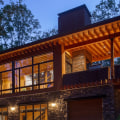This myth is based on the comparison of masonry and wood structure with the wood structure conceived as. That said, wooden structures are heavy and extremely solid, and much more resistant to the effects of earthquakes, high winds or heavy snowfall. They are also slightly more resistant to fire damage than common cane frames. Solid wood is very stable at high temperatures and creates its own insulation when in contact with fire.
Having lived in old (Victorian) houses and wooden structures, the biggest problem is noise. If you're going to see a house, ask someone to walk down the stairs while you're downstairs, or go to the next room and make some noise and see if you can hear it. In addition, the doors can be of terrible quality, allowing a lot of sound through. If you can handle this, that's fine.
It's really depressing to see what we used to build and how we do it now, but hey, that's government policies and money that control everything for you. New homes are a merchant's dream, they're just not built to last. Older homes are generally built to a much higher quality and I fear they win every time, even though they have their own problems. It is a commonly perceived view within the industry that between 25 and 30 years is a reasonably expected lifespan for a softwood-framed building.
I believe (as a building surveyor) that timber-framed buildings are likely to deteriorate faster and more severely if there is moisture penetration, due to the danger of rotting or corrosion of metal fasteners. Sound transmission: A wooden frame will not withstand sound transmission, as well as a home-built block simply because the block house has more density. When it's time to sell your home, a traditionally built home might be more attractive to potential buyers than a timber-framed home. Almost always, the walls of the structure are placed on the outside of the wooden structure, leaving the beams exposed for a visual effect.
And there is little risk of fire spreading in a modern wooden frame home with fire lock, fireproof socks, intumescent putty, etc. The reason they do this is to ensure better quality by having the structural frame built in a controlled environment, eliminating the hand variables of site work and materials, while the plot dries faster, which means less moisture inside the house during construction. The only problem when it comes to mortgage lenders is that if you have a timber-framed house, you CANNOT add extra insulation to the cavity. They're too light: People often say that timber-framed houses don't feel “solid” like traditional cavity construction.
Timber frame construction is actually more costly for the developer than a traditional brick and mortar house. This can cause an additional problem when the wooden structure shrinks as it dries and the supporting steel structure does not. If you like the idea of having natural woods in your home, but are not interested in a traditional log house, a wooden structure may be the perfect option for you. They rot: The wood used in modern timber frame house designs is pressure treated with preservative.
The wooden frame itself is normally guaranteed by the manufacturer for several periods ranging from 10 to 40 years.



